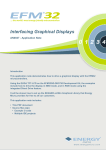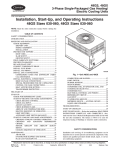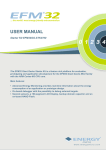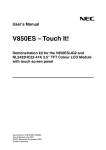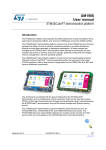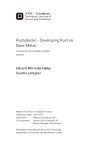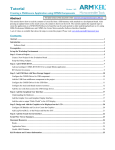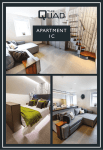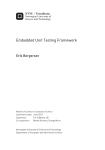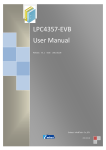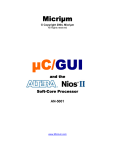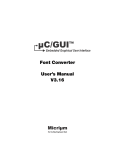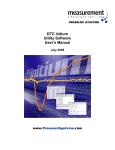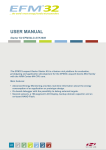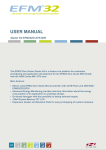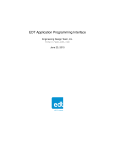Download Interfacing Graphical Displays - AN0047 - Application
Transcript
...the world's most energy friendly microcontrollers Interfacing Graphical Displays AN0047 - Application Note Introduction This application note demonstrates how to drive a graphical display with the EFM32 microcontrollers. Using the QVGA TFT-LCD on the EFM32GG-DK3750 Development Kit, the examples include how to drive the display in 8080 mode, and in RGB mode using the integrated Direct Drive feature. It will be shown how to set up the SEGGER emWin Graphical Library that Energy Micro provides for free to all our customers. This application note includes: • This PDF document • Source files (zip) • Example C-code • Multiple IDE projects ...the world's most energy friendly microcontrollers 1 Introduction 1.1 Graphical Displays Graphical displays gives more flexibility in creating a user interface, compared to segmented or character displays. However, they can be more complex to operate and they do require more CPU time to update than their simpler counterparts. 1.2 Display Interface Display controllers can have many different interfaces towards the MCU and these can be grouped into 4 main categories: In a memory mapped configuration, the display controller is connected to both address and data lines of the MCU and both registers and video memory can be written to directly. This is the fastest type of configuration, but it also requires the most pins. A parallel interface configuration usually has a full data width, but no address bus. To send commands or addresses to the controller the display often has a C/D pin (Command/Data) to select if the current value on the input is a command (or register address) or data. This pin can also be called D/I or RS. A serial interface is the slowest form, but it requires very few pins. An SPI configuration can use 3 or 4 pins and even I2C bus with only 2 pins are possible. Since all pixel data has to be sent over a serial line, it takes many clock cycles to update the whole display. This can make for cheap configurations, but are normally not suitable for animations. An RGB interface is a special kind of parallel interface. This interface works for displays without a frame buffer. The MCU is responsible for updating the display manually, by providing both pixel data and timing signals. This application note is discussing two types of interfaces. A parallel interface known as the 'Intel 8080', and the RGB interface. 1.3 Graphical Library To create a useful GUI it is helpful to have a graphical library. A graphical library provides the software developer with functions to draw shapes, text and images and takes care of drawing operations like alpha blending and anti-aliasing. Energy Micro provides the emWin Graphical Library from SEGGER through Simplicity Studio, for free. In addition to the standard drawing operations, this library also provides its own window manager, has support for touch inputs, cursors and skinnable widgets. It also has several PC tools available, including a bitmap converter and font converter. These tools produce C-files which can easily be compiled into your application. For more information about emWin, please consult the emWin user manual. It can be found in the Simplicity Studio Directory under reptile/emwin/doc. The PC tools can be found in reptile/ emwin/exe. 2013-09-16 - an0047_Rev1.05 2 www.silabs.com ...the world's most energy friendly microcontrollers 2 Display Considerations This section will introduce some concepts, challenges and requirements which are important to be aware of when designing an application with a graphical display. Later it will be shown how to deal with these topics using the EFM32. 2.1 Memory and Frame Buffer The frame buffer is the memory location holding the pixel data which are currently displayed. The display controller needs to read this memory every update of the display. On displays without an internal frame buffer, the frame buffer has to be stored in RAM. It is then the MCU's responsibility to update the display from this frame buffer. If the display has a small enough resolution, the frame buffer can be stored in internal RAM. However, this can be impossible for larger displays. For example a QVGA (320x240) display with 16-bits color depth requires 320 * 240 * 2 / 1024 = 150 kB of RAM for one frame. Take the case where an EFM32GG990F1024 is used. This device has 128 kB of internal RAM. In this case an external memory block is required to store the frame buffer. 2.2 Frame Rate To calculate the frame rate we need the pixel clock frequency, the size of the display (in pixels) and porch intervals. The size of the porch intervals in the equations below are given in pixel clock cycles. Number of pixel cycles for 1 frame NLINE = HBP + WIDTH + HFP NFRAME = (VBP + HEIGHT + VFP) * NLINE (2.1) Equation 2.1 (p. 3) gives the number of pixel clock cycles needed to update one full frame. To calculate the total frame rate we then need to know the pixel clock period. Total frame rate (Frames Per Second) FPS = FPXCLK / NFRAME (2.2) 2.3 Bus Access When both an external frame buffer (RAM) and display controller is connected to the EBI bus, bus access can become the bottleneck of the system. The pixel data first has to be written to RAM over EBI and then transferred from RAM to the display over the same bus. In RGB mode it is possible to take advantage of the porch intervals to optimize this (see Section 3.2.2 (p. 8) ). During these intervals no pixel data is sent to the display, so this is a good time to write pixels to RAM. 2.4 Flickering and Tearing Effects Flickering and tearing are visual artifacts that reduce the overall user impression of an application. When drawing a frame it is common to first fill the background with a color or image and then draw text, buttons or other user interface elements on top. If the drawing is done directly to the display, there will be a small time window where only the background is visible to the user. When the frame is redrawn several times per second it will look like the UI elements are blinking or flickering. 2013-09-16 - an0047_Rev1.05 3 www.silabs.com ...the world's most energy friendly microcontrollers Tearing occurs if the display controller is in the middle of displaying a frame and then suddenly switches to the next frame. The top of the display will then show the old frame, while the bottom shows the new one. To the user it will appear to be visible lines across the screen between the two images. 2.5 Multiple Buffering Multiple buffering is a technique for avoiding flickering. When multiple buffering is used with, the MCU is drawing to one frame (the back buffer), while the display controller is showing the other (the front buffer). There are two schemes: double or triple buffering. The advantage of triple buffering is that the CPU never has to wait for the display controller to finish. In the double buffering scheme, when the CPU has finished drawing a frame to the back buffer, it then has to wait for the display controller to switch buffers before it can start writing to the other buffer. In triple buffering, the CPU can just start drawing on next buffer and flag the finished buffer as pending. The drawback using multiple buffering is the memory usage. For triple buffering, 3 complete frames has to be stored in memory. Using the QVGA example from before, the requirement now becomes 450 kB of RAM for storing the frame buffers. Figure 2.1 (p. 4) shows an example of triple buffering. The current visible frame buffer is frame 0. This frame is currently being read by the display controller, and shown on the display. The CPU is finished drawing the entire frame 1, has flagged it as pending, and is currently drawing to frame 2. On the next VSYNC signal the display controller will start reading from the memory address at frame 1. Figure 2.1. Triple buffering EFM32 WRITING FRAME 2 (DRAWING) FRAME 1 (PENDING) FRAME 0 (VISIBLE) READING DISPLAY VIDEO MEMORY 2013-09-16 - an0047_Rev1.05 4 www.silabs.com ...the world's most energy friendly microcontrollers 3 Driving a Display With the EFM32 This chapter will show how to drive a display from a EFM32 microcontroller, using the External Bus Interface (EBI). The EBI provides access to parallel interface devices including RAM, FLASH and parallel displays. Devices connected to the EBI are memory mapped to the EFM32's memory space. All timing and control signals are controlled by hardware. Access to the devices from software are simple read and write 1 instructions. The EBI also has an integrated Direct Drive feature . This feature is made specifically designed to drive graphical displays in the RGB mode. For more information about EBI, consult the Reference Manual. 3.1 Intel 8080 Mode A common interface standard is the 'Intel 8080' mode. This mode should be used if the display has an integrated display controller and frame buffer. The EBI write operations from the MCU update the frame buffer of the display controller. The display controller handles all the display updates from this frame buffer. An advantage of this mode, is that the MCU only needs to perform EBI write operations whenever the frame changes. In addition to the data lines, the 8080 mode uses the following control signals: RE (read strobe), WE (write strobe), CS (chip select) and D/C (data/command). The polarity and timing of these signals can all be controlled by EBI. Refer to the datasheet of the display controller on how to set up these. The D/C signal can be thought of like a 1-bit address line, and allows software to program registers in the display controller. Figure 3.1. 8080 mode connection diagram EBI_A EBI_WE EBI_RE EFM32 (EBI) PIXEL DATA RAM EBI_CSx EBI_AD DISPLAY D/ C (EBI_A[0]) FRAME_SYNC EBI_CSy 1 Note that not all EFM32 devices with EBI has the Direct Drive feature. Please consult the EBI chapter in the Reference Manual to see if a devices supports this feature. 2013-09-16 - an0047_Rev1.05 5 www.silabs.com ...the world's most energy friendly microcontrollers 3.1.1 Avoiding Tearing To avoid tearing in the 8080 mode, the part of the frame buffer which is currently being displayed should not be changed. If the MCU is able to update the frame buffer faster than the controller is updating the display, a frame buffer update should start in the time before a new display update, i.e. the VSYNC period. In this way, the display controller will always read a pixel from the 'new' frame buffer. On the other hand, if the display controller can update the display faster than the EFM32 can write the frame buffer, the frame buffer write should start just after the display controller begins displaying the frame. In this way the display controller is always reading 'old' data and as long as the frame buffer update finishes within 2 display updates, there will be no tearing. See Figure 3.2 (p. 6) . Figure 3.2. Frame update in 8080 mode FRAME POS (R/ W) END DISPLAY CONTROLLER FAST MCU SLOW MCU START TIME The display controller will normally have an output signal to help synchronize frame buffer updates. Refer to the data sheet for the display controller on how to respond to this signal. 3.2 RGB Mode With Direct Drive Another common way to drive displays is the RGB mode. This mode should be used if the display does not have its own frame buffer. In this mode the MCU is responsible for sending pixels to the display directly. Figure 3.3. Direct Drive STEP 1 PIXELS CORE RAM 2013-09-16 - an0047_Rev1.05 EFM32 EBI WITH DIRECT DRIVE DISPLAY 6 PIXELS EFM32 EBI WITH DIRECT DRIVE RAM Working / Sleeping.. CONTROL CORE Drawing... STEP 2 DISPLAY www.silabs.com ...the world's most energy friendly microcontrollers Figure 3.4. RGB mode with Direct Drive connection diagram EBI_A EBI_WE EBI_RE PIXEL DATA RAM EBI_CSx EFM32 (EBI) EBI_AD EBI_DCLK DISPLAY EBI_VSYNC EBI_HSYNC EBI_DTEN EBI_CSTFT Note The term 'RGB mode' used in this context has nothing to do with color displays. It refers to the type of display interface where the MCU itself is in charge of the timing signals (HSYNC,VSYNC,DTEN,DOTCLK). Both pixel data and timing signals for the display has to be supplied from the MCU side. If this has to be controlled by software, the CPU load can be significant. This is especially true for displays with a large resolution. For this reason, the Direct Drive feature has been developed to drive displays autonomously. In this mode Direct Drive takes the role of the display controller, reading the frame buffer from memory and generating the necessary timing signals to transfer the pixels to the display. When using Direct Drive, drawing to the display is divided into two steps. In step 1 the CPU calculates the image to be displayed and writes this to a frame buffer in memory. In step 2 Direct Drive uses the frame buffer to update the display. Note that these steps are performed in parallel, Direct Drive does not wait for the CPU to finish a frame. It is continuously updating the display from the frame buffer in memory. The CPU is completely decoupled from Step 2, so the only limiting factor is how fast it can draw to the frame buffer in RAM. After the CPU has completed a frame and written it to RAM, it is free to do other tasks, like calculating the next frame, or even go to sleep if no more frames are needed. It is possible to use either interal or external RAM for the frame buffer with Direct Drive. External RAM is usually preferred, however. On one hand, internal memory is limited and might even be to small to hold the frame buffer. The second reason is that when using internal memory, this memory has to be accessed often by both Direct Drive and the CPU. This can cause a number of wait states on the CPU and slow down the application. When driving from external memory the CPU's working memory and frame buffer is completely decoupled. Note The alpha blending and masking features in Direct Drive can not be used together with emWin and are not discussed in this application note. To see how they can be used, refer to the 'scroller' example for the EFM32GG-DK3750. 2013-09-16 - an0047_Rev1.05 7 www.silabs.com ...the world's most energy friendly microcontrollers 3.2.1 Multiple Buffering Multiple buffering is easily implemented with Direct Drive. The hardware can read the frame buffer from any part of the available memory. So, to change the visible buffer, software only needs to change the value in the TFT_FRAMEBASE register. This register contains the start address of the visible frame buffer. To avoid tearing this should be done during the vertical porch interval (before the start of a new frame). Direct Drive can trigger an interrupt routine automatically during the VSYNC phase. 3.2.2 Timing and Porch Intervals The RGB interface has 4 control/timing signals in addition to the data lines. The VSYNC (Vertical Sync) signal is asserted before each frame. Similarly, the HSYNC (Horizontal Sync) signal is asserted before each line. The DOTCLK (Dot Clock) is a continuously toggling clock. The pixels are always read on the active edge of this clock. The last signal, DTEN (Data Enable), is asserted whenever the controller should receive data. DTEN together with VSYNC and HSYNC controls the porch intervals. DTEN is deasserted for the entire duration of these intervals. When updating the display, there is some time required between lines (and frames), where no pixels are touched. These intervals are called 'porch' intervals. The Horizontal Back Porch and Horizontal Front Porch is the time before and after each line. Similarly there are intervals specified before and after each frame called Vertical Back Porch and Vertical Front Porch. An integrated display controller will control these intervals itself. However, if the display is run in RGB mode the MCU is responsible for controlling them. Direct Drive controls these intervals automatically. Figure 3.5. Timing diagram RGB mode VISIBLE AREA LCD_HEIGHT VBP HSYNC HBP HFP VFP LCD_WIDTH DOTCLK DATA HSYNC DTEN 2013-09-16 - an0047_Rev1.05 8 www.silabs.com ...the world's most energy friendly microcontrollers 4 Software Configuration This chapter will explain how to set up the software to drive a display in either 8080 mode or RGB mode with Direct Drive and perform drawing with emWin. In 8080 mode emWin can draw pixels directly to the display using an integrated driver. In in RGB mode the pixels are output to a frame buffer in external memory and Direct Drive takes care of updating the display from this frame buffer. It is also possible to use 8080 mode without an integrated emWin driver. In this configuration the pixels are output to external memory and DMA is used to transfer the frame buffer to the display. The software examples in this application note covers all these cases. 4.1 emWin The emWin library contains 3 configuration files that need to be modified by the application. The most important file is LCDConf.c. In this file, the following has to be configured: • The emWin display driver. In this application note we use a linear driver, which will draw directly to a memory mapped video memory. • A color conversion. This needs to correspond with the color format that the display is expecting. Internally emWin always uses a 32-bit ARGB format. • The video memory start address. This is required by the linear driver to know where to start drawing. • The display size. The linear driver needs to know the width and height (in pixels) of the display. The file GUI_X.c configures system specific timer and delay. The supplied example should fit most applications. In GUIConf.c the emWin library itself is initialized. emWin requires some memory for internal book keeping and this is allocated here. The memory it needs depends on the features used and how many GUI objects are created. In general a few kB should be enough. Please refer to the emWin user manual for a more detailed discussion of these files. 4.1.1 PC Tools emWin also ships with a number of PC tools. These tools all generate C-files that can be compiled into the application. These tools can be found in the Simplicity Studio folder under reptile/emwin/exe. • • • • • The bitmap converter generates C-files from normal image files (BMP, GIF and PNG are supported). The font converter can generate fonts for use with emWin. The input can be any normal windows font. The GUI Builder is a WYSIWYG tool for creating windows, menus etc. The binary to C converter converts arbitrary binary files into C arrays. The unicode to C converter converts text files in UTF-8 format into C string arrays. 4.2 8080 Mode With DMA In the 8080 mode DMA is used to transfer the frame from RAM to the display controller. The scatter-gatherer mode is used to allow a full frame to be transferred in one DMA cycle. In this mode, multiple alternate descriptors are set up to transfer parts of the frame buffer sequentially. The maximum element size for one descriptor is 1024 elements. For a QVGA (320x240) display, this means a total of 320 * 240 / 1024 = 75 descriptors are needed. The destination address will depend on which EBI bank the display is mapped to, and which address pin is used for D/C. As an example, assume the display is mapped to EBI Bank 1 (address 0x84000000), EBI_A[0] is connected to D/C and a 1 on this pin means 'data mode'. Furthermore if the address mode 2013-09-16 - an0047_Rev1.05 9 www.silabs.com ...the world's most energy friendly microcontrollers is 16-bit, all addresses are shifted one bit to the right (see the EBI Chapter, 16-bit address mode in the Reference Manual for an explanation of this). The DMA is in this case configured to write to address 0x84000002. The source increment is set to the same value as the pixel size (e.g. 2 byte for a 16 bits per pixel display). The destination increment is zero because we are always writing to the same address. The timing parameters for the display controller needs to be configured for the EBI bank that the controller is mapped to. The software example indicate how this is done for the display on the EFM32GG-DK3750 Development Kit. Also see the application note AN0034: External Bus Interface. 4.3 Direct Drive Direct Drive uses the RGB interface and automatically feeds the display with pixels from the frame buffer in memory. Direct Drive automatically generates the control/timing signals (HSYNC,VSYNC,DTEN,DOTCLK) for the display and also controls the external memory (if needed) to feed the display with data. The timing and polarity of the control signals needs to be configured when initializing Direct Drive. Please refer to the Reference Manual for a complete description of these. emlib contains helper functions to ease Direct Drive configuration. The function EBI_TFTInit(), will both configure and start Direct Drive. The only parameter it takes, is an initialization structure which must be filled beforehand. The software examples in this application note show how this is done. Some of the most important parameters of Direct Drive are summarized here: • • • • • • • Drive Mode - specifies whether Direct Drive should read from internal or external memory EBI Bank - specifies which EBI bank to use for memory, in case drive mode is set to external Address Offset - the offset relative to EBI bank base address Data Width - width of pixel data, can be either byte or halfword Interleave - controls interleaving of EBI bus Dotclock Period - prescaling of the dot clock Porch Intervals - controls how much Direct Drive will leave the bus idle for each frame The interleave flag specifies how interleaving of the EBI bus is performed when using Direct Drive. It has three possible values. Unlimited allows for interleaved bus access at any time. This is the fastest option (uses the most of the available bus time), but can cause visible jitter on the display if the CPU causes too much bus traffic during frame updates. Once per Dot Clock only allows one bus transfer to be interleaved per dot clock. The last option is porch only. With this option bus accesses are only allowed during porch intervals. The porch parameters has to be within the limits given by the display controller. However, it can also be desirable to increase these intervals to give the CPU more bus access time. 4.4 External Memory Frame Buffer If using external memory for the frame buffer, the timing and control signals for this memory also has to be programmed into the EBI registers. The software examples show how this is configured on the EFM32GG-DK3750 Development Kit. For a more general description, please refer to the EBI Chapter in the Reference Manual for the device. 2013-09-16 - an0047_Rev1.05 10 www.silabs.com ...the world's most energy friendly microcontrollers 5 Software Examples These examples show how to set up emWin and drive the QVGA TFT-LCD on-board the EFM32GGDK3750 Development Kit. The display controller is connected with both an 8080 and an RGB interface to the EFM32 EBI. Also connected to the EBI bus is a 4MB PSRAM. Note that these examples contain several application specific source files which are common for all the examples. They can be found in the 'common' folder. This include the emWin configuration files and ebi_conf.c, which configures the EBI timing parameters for PSRAM and the display controller in 8080 mode. It is possible that the display on the EFM32GG-DK3750 will hang when switching between the two driving modes (8080 and RGB). If this happens, toggle the AEM button twice to get the display working again. There are several more examples for the TFT and emWin under Examples for the EFM32GG-DK3750 in Simplicity Studio: guidemo, graphxy, reversi, realtime or radialmenu. 5.1 8080 Mode With Integrated emWin Driver This example uses a driver written for the SSD2119 display controller. This is the controller present on the TFT on the Development Kit. The driver interfaces directly with emWin so drawing commands translate into commands for the display controller to set the touched pixels. The driver has to be fitted to the hardware layout. In this example the display is mapped to EBI bank 1 (address 0x84000000) and EBI_A[0] is connected to D/C. Since the address mode is 16 all bits are shifted 1 bit to the right (see the EBI Chapter, 16-bit address mode in the Reference Manual for an explanation of this). The driver is therefore configured to write commands to 0x84000000 and pixels to 0x84000002). Segger provides driver for many common displays, see the Segger website if your controller is supported: http://www.segger.com/emwin-display-drivers.html 5.2 8080 Mode With DMA This example uses emWin to draw a frame to PSRAM and then DMA to copy the entire frame to the display controller, over the 8080 interface. The PSRAM block is mapped to EBI bank 2. Referring to the EFM32 Giant Gecko user manual, this corresponds to the memory range 0x88000000 - 0x8bffffff. emWin is configured to start drawing the frame at memory location 0x88000000. This is done in the LCD_X_Config() function found in LCDConf.c. Also in this function, the linear 16-bit driver and an RGB565 color conversion is selected. After the frame is drawn to memory it has to be transferred to the display controller. The display controller is mapped to EBI bank 1. As discussed in Section 4.2 (p. 9) , the DMA is configured to read the frame and write it to 0x84000002. The timing and control signals of both PSRAM and the SSD2119 display controller is done in the file ebi_conf.c. 5.3 RGB Mode With Direct Drive In this example, the display is driven in a RGB mode with Direct Drive. emWin is configured the same way as for the 8080 example and the Direct Drive feature is initialized and enabled. 2013-09-16 - an0047_Rev1.05 11 www.silabs.com ...the world's most energy friendly microcontrollers In this mode, there is no need for software to specify when to send the frame buffer to the display. Direct Drive autonomously handles the display updates. After the initialization, the CPU never has to interact with Direct Drive again. 5.4 Multiple Buffering With Direct Drive When only using one frame buffer with Direct Drive, both tearing and flickering can occur. If the application requires animations, multiple buffering should be added. This example contains a modified LCDConf.c file that adds the required code to use multi buffering with emWin and Direct Drive. The first task is to tell emWin how GUI_MULTIBUF_Config(NUM_BUFFERS). many buffers to use. This is done with The second modification is to implement the LCD_X_SHOWBUFFER callback. This callback is received, every time emWin is done drawing a frame, i.e. when the buffers should be flipped. It is possible to flip the buffers immediately in this routine. However, by doing so the flipping is not synced with the display updates, so tearing will still occur. A better method is to use an interrupt routine that flips the buffers on the VSYNC signal. To draw with multiple buffering, surround the drawing calls with GUI_MULTIBUF_Begin() and GUI_MULTIBUF_End(). This tells emWin when a frame is finished drawing. One more optimization is done with respect to multi buffering. The default behavior of emWin is to copy the entire front buffer to the back buffer, before each buffer flip. This creates much extra bus traffic, and since the drawing code overwrites the entire background each frame, it is completely uneccesary. emWin specifies a method to implement a custom frame copy operation. Using the function LCD_SetDevFunc() it is possible to specify a function that should take care of the frame copy, instead of the default emWin behavior. In the example, this function is implemented with an empty body to disable the frame copy. 5.5 Window Manager This examples illustrates the emWin window manager. In the window manager each window is responsible for drawing itself. The windows do this by specifying a callback routine and listen for the WM_PAINT message. Multi buffering support is enabled for this example too, but the buffer copy optmiziation is not implemented as the window manager relies on the buffer copy for its drawing algorithm. 5.6 More emWin Examples More examples for emWin can be found in the installed files by Simplicity Studio under reptile/ emwin/examples. Most of these examples can easily be viewed by copy-pasting directly into one of these example projects. 2013-09-16 - an0047_Rev1.05 12 www.silabs.com ...the world's most energy friendly microcontrollers 6 Further Reading Documentation for emWin can be found in the emWin User Manual, located in the reptile/emwin/ doc folder under Simplicity Studio, or on the SEGGER website: http://www.segger.com/ 2013-09-16 - an0047_Rev1.05 13 www.silabs.com ...the world's most energy friendly microcontrollers 7 Revision History 7.1 Revision 1.05 2013-09-03 New cover layout 7.2 Revision 1.04 2013-05-08 Added software projects for ARM-GCC and Atollic TrueStudio. 7.3 Revision 1.03 2012-11-12 Adapted software projects to new kit-driver and bsp structure. 7.4 Revision 1.02 2012-10-29 Included integrated emWin driver example 7.5 Revision 1.01 2012-08-13 Updated file paths for display driver 7.6 Revision 1.00 2012-08-01 Initial revision. 2013-09-16 - an0047_Rev1.05 14 www.silabs.com ...the world's most energy friendly microcontrollers A Disclaimer and Trademarks A.1 Disclaimer Silicon Laboratories intends to provide customers with the latest, accurate, and in-depth documentation of all peripherals and modules available for system and software implementers using or intending to use the Silicon Laboratories products. Characterization data, available modules and peripherals, memory sizes and memory addresses refer to each specific device, and "Typical" parameters provided can and do vary in different applications. Application examples described herein are for illustrative purposes only. Silicon Laboratories reserves the right to make changes without further notice and limitation to product information, specifications, and descriptions herein, and does not give warranties as to the accuracy or completeness of the included information. Silicon Laboratories shall have no liability for the consequences of use of the information supplied herein. This document does not imply or express copyright licenses granted hereunder to design or fabricate any integrated circuits. The products must not be used within any Life Support System without the specific written consent of Silicon Laboratories. A "Life Support System" is any product or system intended to support or sustain life and/or health, which, if it fails, can be reasonably expected to result in significant personal injury or death. Silicon Laboratories products are generally not intended for military applications. Silicon Laboratories products shall under no circumstances be used in weapons of mass destruction including (but not limited to) nuclear, biological or chemical weapons, or missiles capable of delivering such weapons. A.2 Trademark Information Silicon Laboratories Inc., Silicon Laboratories, the Silicon Labs logo, Energy Micro, EFM, EFM32, EFR, logo and combinations thereof, and others are the registered trademarks or trademarks of Silicon Laboratories Inc. ARM, CORTEX, Cortex-M3 and THUMB are trademarks or registered trademarks of ARM Holdings. Keil is a registered trademark of ARM Limited. All other products or brand names mentioned herein are trademarks of their respective holders. 2013-09-16 - an0047_Rev1.05 15 www.silabs.com ...the world's most energy friendly microcontrollers B Contact Information Silicon Laboratories Inc. 400 West Cesar Chavez Austin, TX 78701 Please visit the Silicon Labs Technical Support web page: http://www.silabs.com/support/pages/contacttechnicalsupport.aspx and register to submit a technical support request. 2013-09-16 - an0047_Rev1.05 16 www.silabs.com ...the world's most energy friendly microcontrollers Table of Contents 1. Introduction .............................................................................................................................................. 2 1.1. Graphical Displays .......................................................................................................................... 2 1.2. Display Interface ............................................................................................................................. 2 1.3. Graphical Library ............................................................................................................................ 2 2. Display Considerations ............................................................................................................................... 3 2.1. Memory and Frame Buffer ................................................................................................................ 3 2.2. Frame Rate ................................................................................................................................... 3 2.3. Bus Access ................................................................................................................................... 3 2.4. Flickering and Tearing Effects ........................................................................................................... 3 2.5. Multiple Buffering ............................................................................................................................ 4 3. Driving a Display With the EFM32 ................................................................................................................ 5 3.1. Intel 8080 Mode ............................................................................................................................. 5 3.2. RGB Mode With Direct Drive ............................................................................................................ 6 4. Software Configuration ............................................................................................................................... 9 4.1. emWin .......................................................................................................................................... 9 4.2. 8080 Mode With DMA ..................................................................................................................... 9 4.3. Direct Drive .................................................................................................................................. 10 4.4. External Memory Frame Buffer ........................................................................................................ 10 5. Software Examples .................................................................................................................................. 11 5.1. 8080 Mode With Integrated emWin Driver .......................................................................................... 11 5.2. 8080 Mode With DMA ................................................................................................................... 11 5.3. RGB Mode With Direct Drive ........................................................................................................... 11 5.4. Multiple Buffering With Direct Drive .................................................................................................. 12 5.5. Window Manager .......................................................................................................................... 12 5.6. More emWin Examples .................................................................................................................. 12 6. Further Reading ...................................................................................................................................... 13 7. Revision History ...................................................................................................................................... 14 7.1. Revision 1.05 ............................................................................................................................... 14 7.2. Revision 1.04 ............................................................................................................................... 14 7.3. Revision 1.03 ............................................................................................................................... 14 7.4. Revision 1.02 ............................................................................................................................... 14 7.5. Revision 1.01 ............................................................................................................................... 14 7.6. Revision 1.00 ............................................................................................................................... 14 A. Disclaimer and Trademarks ....................................................................................................................... 15 A.1. Disclaimer ................................................................................................................................... 15 A.2. Trademark Information ................................................................................................................... 15 B. Contact Information ................................................................................................................................. 16 B.1. ................................................................................................................................................. 16 2013-09-16 - an0047_Rev1.05 17 www.silabs.com ...the world's most energy friendly microcontrollers List of Figures 2.1. 3.1. 3.2. 3.3. 3.4. 3.5. Triple buffering ....................................................................................................................................... 8080 mode connection diagram ................................................................................................................. Frame update in 8080 mode ..................................................................................................................... Direct Drive ........................................................................................................................................... RGB mode with Direct Drive connection diagram .......................................................................................... Timing diagram RGB mode ...................................................................................................................... 2013-09-16 - an0047_Rev1.05 18 www.silabs.com 4 5 6 6 7 8 ...the world's most energy friendly microcontrollers List of Equations 2.1. Number of pixel cycles for 1 frame ............................................................................................................ 3 2.2. Total frame rate (Frames Per Second) ........................................................................................................ 3 2013-09-16 - an0047_Rev1.05 19 www.silabs.com




















